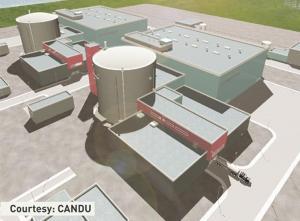
Nuclear energy and climate change
The environmental science is clear: The world needs to eliminate virtually all greenhouse gas (GHG) emissions by 2100 to limit surface-level warming to two degrees above preindustrial levels.

How should we do this, and how can nuclear energy help?
The International Energy Agency (IEA) says the world needs first to cap the GHG emissions growth rate, and then to cut emissions dramatically.
To cap emissions growth by 2020, the IEA recommends five steps:
- Increase energy efficiency in industry, buildings and transport sectors.
- Reduce the use of the least-efficient coal-fired power plants and ban new coal plants.
- Increase power-sector investment in renewable energies.
- Phase out fossil-fuel subsides to most end users by 2030.
- Reduce methane emissions from oil and gas production.
No nuclear? No, because it can take ten years to build a nuclear plant and start it up, and the IEA cap is a five-year plan.
But the IEA puts nuclear energy at the centre of its GHG-cutting approach: The world should double electrical output from nuclear energy by 2040, while also investing massively in renewable energy and carbon capture and storage.
Those three actions would deliver about two-thirds of the GHG cuts needed by 2040, and put the world on a two-degree path.
Interestingly, carbon capture and storage would deliver about 46 percent of the cuts, and renewables only five percent. Nuclear would deliver 11 percent – twice as much as renewables.
Can it be done? Is this proposed increase in nuclear capacity at all feasible?
The history of nuclear construction suggests that this ambitious capacity increase is feasible. As the International Atomic Energy Agency (IAEA) points out, the global nuclear fleet expanded fivefold between 1970 and 1990; its capacity multiplied by 20 times. That’s a far higher growth rate than the one the IEA calls for in its two-degree plan.
Nuclear energy drew few mentions in the build-up to the COP21 climate talks in Paris. But its ability to help solve the climate change problem is evident.
The bottom line: if the world is serious about climate change, it’s time to get serious about nuclear energy.
| INDC Scenario | Bridge Scenario | 450 Scenario | |
| Indicative long-term temperature increase (°C) | +3.5 | +2.8 | +2 |
| CO2 emissions in 2030 relative to 2013 | |||
|
8% | -4% | -21% |
|
0 | -21% | -47% |
| Total electrical output (TWh) | |||
|
27,652 | 26,734 | 26,662 |
|
30,454 | 28,672 | 28,255 |
|
33,327 | 30,620 | 29,930 |
| Nuclear electrical output (TWh) | |||
|
3,226 | 3,226 | 3,276 |
|
3,600 | 3,598 | 3,894 |
|
4,008 | 4,005 | 4,880 |
| Nuclear installed capacity (GWe) | |||
|
449 | 449 | 456 |
|
490 | 490 | 529 |
|
542 | 542 | 660 |



